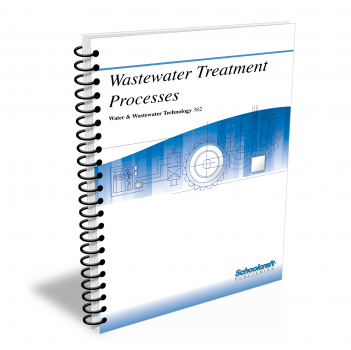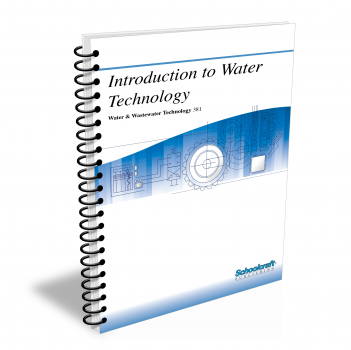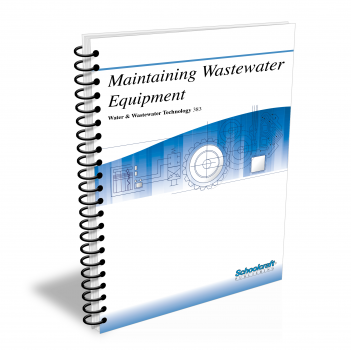Wastewater Treatment Processes

Course Number: 382
The Wastewater Treatment Prcesses textbook covers the various stages of wastewater treatment. It goes into detail on the removal of solids, then explains the use of chemical and biological processes for water purification. Finally, it covers the treatment and disposal of the extracted solids.
Does your curriculum require additional topics not included in this textbook? Build a customized version of the Wastewater Treatment Processes textbook below.
Recommended Contact Hours – 10
Preview a Chapter
Available Supporting Material
- Table of Contents
- Exam Copies
- Suggested Titles
Table of Contents
Chapter 1: Overview of Wastewater Treatment
Topics: Collection systems; Treatment facilities; Influent; Preliminary, primary, secondary, and tertiary treatment; Disinfection; Solids handling
Learning Objectives:
- List the purposes of wastewater treatment.
- Describe the way organic wastes pollute water.
- Identify elements of wastewater collection systems.
- Outline the stages of wastewater treatment at the typical treatment facility.
- Explain what happens to wastewater during preliminary, primary, secondary, and tertiary treatment.
- Describe methods of solids handling.
Chapter 2: Physical Separation of Solids
Topics: Screening; Grinding; Grit removal; Sedimentation; Clarifiers; Air flotation; Filtration; Effluent disposal
Learning Objectives:
- Identify and describe the different types of bar and woven screens used for screening.
- Identify and describe common types of grit-removal equipment.
- List factors affecting settling rates.
- Figure the length of detention time needed to settle out settleable particles.
- Describe the three principal methods of land disposal.
Chapter 3: Chemical Treatment Processes
Topics: Solids in wastewater; Chemical coagulants; Phosphate removal; Chemical clarification; Disinfection; Equipment used in chlorine feeding
Learning Objectives:
- Describe what colloidal particles are and outline the problems associated with removing them from wastewater.
- List chemicals used as coagulants.
- Explain how the flocculation process works.
- Explain the function of a precipitant.
- List chemical agents commonly used as disinfectants.
- Identify factors affecting disinfection.
- Describe methods for applying chlorine to wastewater.
Chapter 4: Biological Processes
Topics: Lagoons; Activated sludge; Aeration; Trickling filters; Activated biofilter process; Rotating biological contactors; Secondary clarifiers
Learning Objectives:
- Differentiate between the way unaerated and aerated lagoons function.
- Distinguish between suspended growth and fixed-growth systems.
- List and describe different methods of utilizing activated sludge to stabilize wastewater.
- Tell how trickling filters, ABFs, and RBCs operate.
- Explain how secondary clarifiers are used in conjunction with fixed- and suspended-growth systems.
Chapter 5: Solids Treatment and Disposal
Topics: Sludge conditioning; Thickening; Dewatering; Drying beds; Lagoons; Vacuum filtration; Filter presses; Composting; Ultimate disposal
Learning Objectives:
- Distinguish between conditioning, thickening, and dewatering.
- List the factors that affect which conditioning, thickening, and dewatering methods are used.
- Describe four methods of sludge conditioning.
- Describe three methods of thickening.
- List factors that affect drying-bed operation.
- Describe methods for disposing of digested or dewatered sludge.
Request Exam Copies
Exam Copies
Ready to see a copy of our textbooks? After selecting which textbooks you’d like to review for your course, you can submit your request by either logging in or creating an account so we know where to ship your exam copies. A representative from Schoolcraft will contact you to confirm and finish processing your request.
Exam copies are always free and yours to keep.
Selected Exam Copies
none selected
* Maximum of five copies can be ordered

